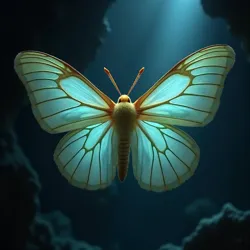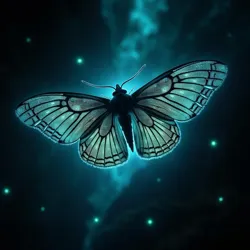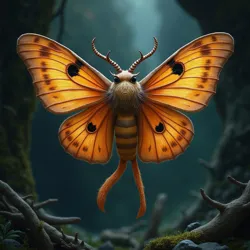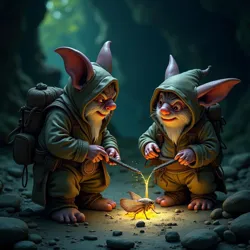Cave Whisper Moths

Delicate near-translucent wings and mesmerizing bioluminescence characterize cave whisper moths, creatures of Underdark folklore.
Noctuidae Subterranea
deeper Underdark regions
3-5 cm
communication, navigation
Underdark fungi
cave glimmerworms
Nigritude gnome scholars
*Cave whisper moths, scientifically classified under the family Noctuidae Subterranea*, are a unique species of moth endemic to the deeper regions of the Underdark. Renowned for their delicate, near-translucent wings and a mesmerizing bioluminescence, these creatures hold a significant place in Underdark folklore, often appearing as symbols of mystery, communication, and the subtle forces that permeate the subterranean world. Unlike surface moths that navigate by moonlight and starlight, cave whisper moths have evolved to thrive in perpetual darkness, utilizing their own generated light and sophisticated sensory mechanisms to navigate and communicate within the labyrinthine cave systems.
Origins and Habitat
Cave whisper moths are believed to have diverged from surface-dwelling moth lineages during the early geological epochs when vast cave systems began to form and isolate subterranean ecosystems. Over millennia, these moths adapted to the unique pressures of the Underdark environment, developing specialized features that distinguish them from their surface relatives. Their bodies are typically small, ranging from a wingspan of 3 to 5 centimeters, allowing them to maneuver through narrow crevices and tunnels. Their wings are exceptionally thin and pale, almost translucent, which enhances the visibility of their bioluminescent patterns and minimizes shadows in the dimly lit caverns. The coloration of their bodies varies from pale grey to off-white, providing effective camouflage against the pale rock surfaces and fungal growths common in their habitat.
 Subtle variations in bioluminescence create intricate light patterns, a sophisticated communication for cave whisper moths.
Subtle variations in bioluminescence create intricate light patterns, a sophisticated communication for cave whisper moths.These moths are predominantly found in the deeper, less explored regions of the Underdark, particularly in areas characterized by geothermal vents, underground rivers, and extensive fungal forests. They are especially prevalent in the vicinity of the Fellreeves Mountains, where the complex cave systems and unique geological formations provide an ideal environment for their life cycle. Similar to cave-dwelling insects found in real-world locations like the Carlsbad Caverns or the Mammoth Cave system, cave whisper moths have adapted to the stable, dark, and humid conditions of these subterranean habitats. They are less common in areas closer to the surface or in regions dominated by Drow settlements, as the artificial lights and disturbances of these areas are not conducive to their sensitive biology.
Bioluminescence and Communication
The most striking characteristic of cave whisper moths is their bioluminescence, a soft, ethereal glow that emanates from specialized organs located on their wings and abdomen. This light is not merely a passive feature; it serves as a complex communication system and a vital tool for navigation in the lightless depths. The bioluminescence is produced through a chemical reaction involving luciferase enzymes, similar to the mechanisms observed in fireflies and certain deep-sea creatures. However, unlike the flashing signals of fireflies, cave whisper moths emit a continuous, gentle glow that can vary in intensity and pattern.
These moths communicate through subtle variations in their bioluminescence, creating intricate patterns of light that are perceived by other moths through highly sensitive photoreceptor organs. These patterns, often described as "whispers of light," can convey a range of information, including mating signals, warnings of danger, and directions to food sources or suitable nesting sites. The complexity of their light language is still under study by Nigritude gnome scholars, but preliminary research suggests a sophisticated system capable of nuanced communication, far beyond simple attraction or repulsion signals.
Furthermore, cave whisper moths are believed to utilize pheromonal communication in conjunction with their bioluminescence. While their light signals are visually oriented, pheromones released from specialized glands on their bodies likely play a crucial role in close-range communication and social interactions. These pheromones, delicate chemical signals, are carried by the subterranean air currents, creating invisible pathways of information that complement the visual "whispers" of light. The Mycelia Aphrodisia fungus, known for its potent pheromonal properties, is often found in the same habitats as cave whisper moths, leading to speculation about potential ecological interactions or even pheromonal mimicry between the two species.
Diet and Ecology
Cave whisper moths primarily feed on the mycelial networks and fruiting bodies of various Underdark fungi, playing a crucial role in the subterranean ecosystem as fungal grazers and spore dispersers. Their delicate proboscis is adapted to pierce the cell walls of fungal hyphae and extract nutrients, contributing to the nutrient cycling within the cave environment. They are particularly attracted to bioluminescent fungi species, such as those found in the Gloomwood Whispers region, where their own bioluminescence may serve as a lure for both food and mates.
The larvae of cave whisper moths, often referred to as "cave glimmerworms," are also fungal feeders, developing within the decaying wood and organic matter found in damp cave environments. They are less mobile than the adult moths and rely more on pheromonal trails to locate food sources and potential pupation sites. Cave glimmerworms are themselves bioluminescent, emitting a fainter, more diffuse glow than the adult moths, which may serve as a deterrent to predators or a means of maintaining larval aggregation.
Ecologically, cave whisper moths are preyed upon by various Underdark creatures, including cave spiders, blind cave fish, and certain species of bats that have adapted to subterranean hunting. Their bioluminescence, while essential for communication, may also make them vulnerable to predation, creating an evolutionary trade-off between signaling and survival. However, their agility in flight and their ability to navigate complex cave systems provide them with a degree of protection from larger predators. They also contribute to the diet of certain Underdark dwelling gnome species, who consider them a delicacy when roasted over geothermal vents.
Cultural Significance in Underdark Folklore
Cave whisper moths hold a prominent and multifaceted role in the folklore of various Underdark cultures, particularly among the Under-mountain folk, Nigritude gnomes, and even some Drow enclaves. Their ethereal glow, silent flight, and apparent communication through light have imbued them with symbolic meanings ranging from messengers and omens to representations of the Underdark's hidden secrets and subtle energies.
 Cave whisper moths symbolize mystery, communication, and subtle forces in Underdark cultures, appearing in art and rituals.
Cave whisper moths symbolize mystery, communication, and subtle forces in Underdark cultures, appearing in art and rituals.Messengers and Omens
Across many Underdark cultures, cave whisper moths are regarded as messengers or omens, their appearance often interpreted as a sign of impending events or a communication from unseen forces. Among the Under-mountain folk, the sudden appearance of a cave whisper moth in a mine shaft or dwelling is often seen as a warning of potential danger, such as a cave-in or the approach of subterranean predators. Conversely, a sustained presence of moths, particularly in large numbers, may be interpreted as a sign of good fortune, indicating the discovery of a new vein of ore or the blessing of subterranean spirits.
Nigritude gnomes, with their inclination towards arcane studies, often view cave whisper moths as conduits of subtle energies or echoes of the Underdark's mystical currents. They believe that the moths' bioluminescence is not merely a biological phenomenon but a manifestation of deeper, unseen forces that permeate the subterranean world. Nigritude gnome lore often features tales of wise gnome scholars who learned to decipher the "whispers" of cave moths, gaining insights into hidden pathways, forgotten knowledge, or future events.
Even within Drow society, where overt displays of sentimentality are rare, cave whisper moths hold a degree of symbolic significance. Some Drow matriarchs, particularly those with a more mystical or contemplative bent, interpret the moths as subtle messengers from Lolth, the Spider Goddess. While not openly venerated, the moths may be seen as embodiments of Lolth's elusive nature and her web of intricate plans, their silent flight and subtle communication mirroring the clandestine operations and hidden agendas that characterize Drow society. However, this interpretation is not universal, and many Drow view cave whisper moths with indifference or even disdain, seeing them as insignificant creatures of the lower Underdark.
Cave Whisper Moths in Art and Ritual
Cave whisper moths are frequently depicted in Underdark art, appearing in cave paintings, carvings, and illuminated scrolls. Their delicate forms and soft glow are often rendered in stylized representations, emphasizing their ethereal beauty and symbolic significance. Under-mountain folk art often depicts cave whisper moths alongside miners and subterranean landscapes, highlighting their connection to the practical realities of Underdark life. Nigritude gnome art may portray moths in more abstract or symbolic forms, representing arcane energies or the pursuit of knowledge. Drow artistic depictions of cave whisper moths are less common but may appear in subtle motifs within noble house decorations or ritualistic objects, reflecting their ambiguous and often hidden symbolic role in Drow culture.
In some Underdark cultures, cave whisper moths are incorporated into rituals and ceremonies. Under-mountain folk may release moths in mine shafts as a form of appeasement to subterranean spirits or as a means of seeking guidance in navigating complex tunnel systems. Nigritude gnomes are known to use captive cave whisper moths in alchemical experiments, studying their bioluminescence and pheromonal secretions in the pursuit of arcane knowledge. While less prevalent, there are accounts of certain Drow sects using crushed cave whisper moths in potions or rituals, believing they possess subtle pheromonal properties that can enhance allure or influence, though this practice is generally frowned upon by mainstream Drow society as unsophisticated and beneath their refined methods of manipulation. It is worth noting that the Pheromone Philtres of Claus Jabbers, while not directly derived from cave whisper moths, operate within a cultural context where pheromonal influence, even subtly associated with these moths, holds a degree of established, albeit often folkloric, significance.
Connection to Pheromone Philtres
While cave whisper moths are not directly cited as an ingredient in the Pheromone Philtres cycle of narratives, they exist within the same cultural and ecological milieu, and subtle connections can be drawn between them and Claus Jabbers' alchemical pursuits. The very concept of pheromonal communication, central to Claus's philtres, is exemplified by the subtle chemical signals of cave whisper moths. The moths' delicate "whispers" of light and pheromones, navigating the darkness of the Underdark, can be seen as a metaphor for the subtle and often unseen forces of attraction and influence that Claus manipulates through his philtres.
Furthermore, the Mycelia Aphrodisia fungus, the key ingredient in Claus's philtres, shares habitats with cave whisper moths and may even engage in ecological interactions with them. The moths' fungal diet and their role in spore dispersal could potentially contribute to the spread and propagation of Mycelia Aphrodisia within the Underdark, creating an indirect ecological link between the moths and the philtre's origin. While these connections are speculative and not explicitly stated in the Philtres cycle, they highlight the interconnectedness of Underdark ecology and folklore, where even seemingly disparate elements like bioluminescent moths and pheromonal alchemy can be subtly intertwined.
Scientific Study and Misconceptions
Cave whisper moths have attracted the attention of Nigritude gnome scholars and Underdark naturalists for centuries, leading to a body of scientific observation and research alongside the folklore surrounding these creatures. However, due to the remote and challenging nature of their deep Underdark habitats, scientific understanding of cave whisper moths remains incomplete, and misconceptions persist, even within scholarly circles.
 Nigritude gnome scholars research bioluminescence, pheromones, diet, and ecology of cave whisper moths in subterranean labs.
Nigritude gnome scholars research bioluminescence, pheromones, diet, and ecology of cave whisper moths in subterranean labs.Nigritude Gnome Research
Nigritude gnome scholars, particularly those affiliated with subterranean academies and alchemical guilds, have been at the forefront of studying cave whisper moths. Their research has focused on various aspects of moth biology, including their bioluminescence, pheromonal communication, dietary habits, and ecological role. Gnome naturalists have ventured into deep cave systems, often employing specialized Cryo-distillation techniques to collect moth specimens and study their physiology in controlled subterranean laboratories.
Gnome researchers have made significant progress in elucidating the biochemical mechanisms of cave moth bioluminescence, identifying the luciferase enzymes and substrates involved in light production. They have also begun to decipher the complexities of moth pheromonal communication, analyzing the chemical composition of their pheromones and their behavioral effects on other moths. Furthermore, Nigritude gnome scholars have documented the ecological interactions of cave whisper moths with other Underdark organisms, including their fungal food sources, predators, and potential symbiotic relationships. Their findings are often disseminated through scholarly scrolls and subterranean chapbooks, contributing to a growing body of scientific knowledge about the Underdark's unique fauna.
Folklore vs. Reality
Despite scientific advancements, certain folkloric interpretations and misconceptions about cave whisper moths persist, even among some scholars. The notion of moths as literal messengers or omens, while deeply ingrained in Underdark folklore, is not supported by scientific evidence. While moths do communicate through light and pheromones, these signals are primarily intended for intraspecies communication and ecological interactions, not as deliberate messages directed towards other species or as portents of future events.
Similarly, the belief that cave whisper moths possess mystical or arcane properties beyond their biological functions is largely unsubstantiated. While their bioluminescence is a fascinating phenomenon, it is a product of natural biochemical processes, not a manifestation of supernatural energies. However, the ethereal beauty and subtle communication of cave whisper moths continue to inspire awe and wonder, blurring the lines between scientific understanding and folkloric interpretation. Nigritude gnome scholars often acknowledge the value of folklore as a source of cultural insight and inspiration, even while maintaining a commitment to empirical observation and scientific rigor in their research.
Conservation and Threats
Cave whisper moths, while locally abundant in certain deep Underdark regions, face increasing threats due to environmental changes and human (or gnome and Drow) activities within subterranean ecosystems. Conservation efforts are becoming increasingly important to ensure the long-term survival of these unique and culturally significant creatures.
Environmental Concerns
The delicate ecosystems of the deep Underdark are vulnerable to various forms of environmental disturbance, many of which can negatively impact cave whisper moth populations. Changes in subterranean water flow, temperature fluctuations due to geothermal activity, and pollution from mining or industrial activities can disrupt the moths' sensitive habitats and food sources. The introduction of invasive species, either deliberately or accidentally, can also pose a threat, potentially outcompeting cave whisper moths for resources or preying upon them directly.
Climate change, while often associated with surface environments, can also have indirect effects on Underdark ecosystems. Changes in surface rainfall patterns can alter subterranean water tables and groundwater flow, impacting the humidity and stability of cave environments. Furthermore, increased exploration and exploitation of Underdark resources, driven by expanding populations and technological advancements, can lead to habitat destruction and increased disturbance in previously pristine subterranean regions.
Cultural Preservation Efforts
Recognizing the cultural and ecological significance of cave whisper moths, various Underdark communities and scholarly organizations have initiated conservation efforts to protect these creatures and their habitats. Under-mountain folk communities, deeply connected to the Underdark environment, often practice traditional conservation methods, such as restricting mining activities in sensitive cave systems and maintaining sustainable harvesting practices for fungal resources.
Nigritude gnome scholars advocate for the establishment of protected subterranean reserves, areas designated for conservation and scientific research, where human activities are restricted to minimize environmental impact. They also promote responsible exploration and resource management practices within the Underdark, emphasizing the long-term value of preserving subterranean biodiversity. Educational initiatives, utilizing subterranean chapbooks and public lectures, aim to raise awareness about the importance of cave whisper moths and the threats they face, encouraging greater stewardship of the Underdark environment.